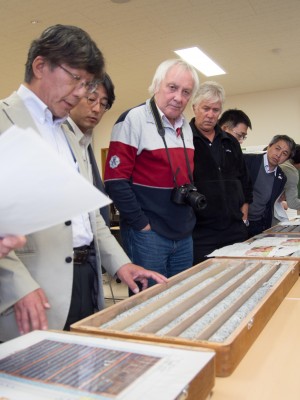
LCC delegation checking the boring core sample of the granite bedrock in Kitakami area. Image: Nobuko Kobayashi
In August 2013, the International Linear Collider site evaluation committee of Japan announced that they evaluated a site in Kitakami as the best candidate location in Japan for the ILC. The exciting news came after meticulous preparation and study to ensure that the site was suitable for the 31-kilometre linear collider. Among the most important criteria in the evaluation was whether or not an earthquake, such as the one that affected Japan in 2011, could cause damage to the ILC.
First and foremost, therefore, was an evaluation of the site’s geology. “No active fault around the Kitakami site has been found so far, and the possibility for the site to have any active faults would be very low,” says Akira Yamamoto, regional director for Asia of the Linear Collider Collaboration. Although some natural fractures in the rock occur in the area, careful study suggests that none would affect construction and installation, the most delicate period for machinery. Once underground, the equipment is actually far safer than at the surface level, since the seismic damage of underground works are generally much less than that of ground buildings.
Crucially, the collider is engineered to remain stable in the event of any disruption. John Osborne, a civil engineer from CERN, explains that safety would not be a critical concern. “If the machine is rattled it will simply abort the beam,” Osborne says. “It’s really just an issue of protecting the equipment.”
At most, an earthquake might do enough damage to cause a crack in the cryogenics system, releasing liquid helium. To prepare for this possibility, ILC scientists are learning from studies at the Large Hadron Collider, where physicists and engineers intentionally leaked liquid helium for safety studies. This is one of several lessons that ILC scientists can learn from other colliders. In the United States, the SLAC National Accelerator Laboratory in California has to be prepared for small but common quakes, for example. ITER, a fusion facility in Southern France, makes use of special pads to absorb shocks from seismic activities.
But an example even closer to the Kitakami site makes ILC leaders feel confident in their preparedness and selection. Akira Yamamoto points to Japan’s Esashi Earth Tides Station as another important case study. There, he explains, the tunnel was held within a single rock mass of granite bedrock, allowing it to experience the earth’s movement as a single block. “It was shaken as one, then restored as one,” says Yamamoto. “This experienced proved that the ILC’s design [also within a single block of rock] can be safely done.”

Recent Comments